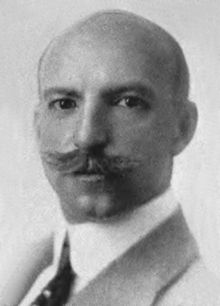History
Universal Studios was founded by Carl Laemmle, Mark Dintenfass, Charles O. Baumann, Adam Kessel, Pat Powers, William Swanson, David Horsley, Robert H. Cochrane, and Jules Brulatour. One story has Laemmle watching a box office for hours, counting patrons and calculating the day's takings. Within weeks of his Chicago trip, Laemmle gave up dry goods to buy the first several nickelodeons. For Laemmle and other such entrepreneurs, the creation in 1908 of the Edison-backed Motion Picture Trust meant that exhibitors were expected to pay fees for Trust-produced films they showed. Based on the Latham Loop used in cameras and projectors, along with other patents, the Trust collected fees on all aspects of movie production and exhibition, and attempted to enforce a monopoly on distribution.
Robert H. Cochrane (1879-1973) formed the Cochrane Advertising Agency in Chicago in 1904. He joined the Laemmle Film Service as advistising manager in 1906, and for the next 30 years devoted himself to promoting Carl Laemmle as the 'star' of their various motion picture enterprises. In 1912 Cochrane was elected vice-president of the Universal Film manufacturing Company, and served as president of Universal in 1936-37 after Laemmle sold his interests. This account of Cochrane's early activities first appeared in Moving Picture World on July 20, 1918, pages 322-323. Project Muse - The Beginning of motion picture press agenting - Film History
Soon, Laemmle and other disgruntled nickelodeon owners decided to avoid paying Edison by producing their own pictures. In June 1909, Laemmle started the Yankee Film Company with partners Abe Stern and Julius Stern. That company quickly evolved into the Independent Moving Pictures Company (IMP), with studios in Fort Lee, New Jersey, where many early films in America's first motion picture industry were produced in the early 20th century.[2][3][4][5] Laemmle broke with Edison's custom of refusing to give billing and screen credits to performers. By naming the movie stars, he attracted many of the leading players of the time, contributing to the creation of the star system. In 1910, he promoted Florence Lawrence, formerly known as "The Biograph Girl," and actor King Baggot, in what may be the first instance of a studio using stars in its marketing.
Universal had a "clean picture" policy. However, by April 1927, Carl Laemmle considered this to be a mistake as "unclean pictures" from other studios were generating more profit while Universal was losing money.

By using an image of the universe is unique because the company is expressing that the films they produce is huge around the globe but also saying that their films are out of this world.
Marv Films
Marv Films do not have much of a history as they were only founded in 2004, which is owned by Matthew Vaughn.

This was Marv's first logos. Marv is unique because they have adapted their logo to the films they make.



No comments:
Post a Comment